James Maliszewski's Blog, page 70
August 1, 2023
Original Polyhedron Art
As I noted in my post about issue #3 of Polyhedron, the newsletter contains a lot of original art by TSR's stable of artists. According to its credits page, here are the artists who contributed one or more pieces to the issue:
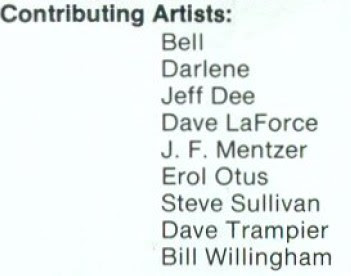 Most of those names should be familiar to aficionados of early '80s TSR Hobbies. The other two that might not be familiar are Bell and J.F. Mentzer. Bell is Greg Bell, who did a lot of the illustrations in the little brown books of OD&D. J.F. Mentzer is not, as I initially thought, Frank Mentzer, whose full name is Jacob Franklin Mentzer III, but rather his father, Jacob Franklin Mentzer II, as we'll see shortly.
Most of those names should be familiar to aficionados of early '80s TSR Hobbies. The other two that might not be familiar are Bell and J.F. Mentzer. Bell is Greg Bell, who did a lot of the illustrations in the little brown books of OD&D. J.F. Mentzer is not, as I initially thought, Frank Mentzer, whose full name is Jacob Franklin Mentzer III, but rather his father, Jacob Franklin Mentzer II, as we'll see shortly.The first piece of artwork I'd like to share from the issue is a depiction of an ice devil by an unknown artist.
 Who's the illustrator? To me, it looks like it could be Dave LaForce, but I am uncertain of that attribution.
Who's the illustrator? To me, it looks like it could be Dave LaForce, but I am uncertain of that attribution.Next up is this excellent Lich by Darlene:
 Darlene also contributed this portrait of a wizard that I rather like.
Darlene also contributed this portrait of a wizard that I rather like.
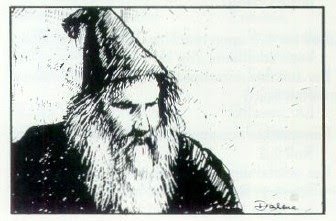 This party of adventurers is definitely the work of Dave LaForce. His signature is clearly visible on the righthand side of the piece, along the magic-user's staff.
This party of adventurers is definitely the work of Dave LaForce. His signature is clearly visible on the righthand side of the piece, along the magic-user's staff.
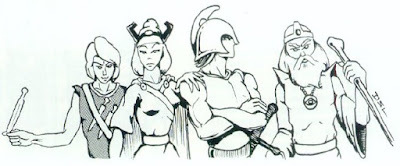 Here's the piece attributed to JFM II, as you can see in the bottom lefthand side of the illustration. I'm not entirely sure what it's meant to depict, though it calls to mind the fairytale of the Frog Prince. In any case, I rather like it, if only because its style is so clearly different from that of the other artwork found in the issue.
Here's the piece attributed to JFM II, as you can see in the bottom lefthand side of the illustration. I'm not entirely sure what it's meant to depict, though it calls to mind the fairytale of the Frog Prince. In any case, I rather like it, if only because its style is so clearly different from that of the other artwork found in the issue.
 And finally there's another Gamma World piece by Erol Otus:
And finally there's another Gamma World piece by Erol Otus:
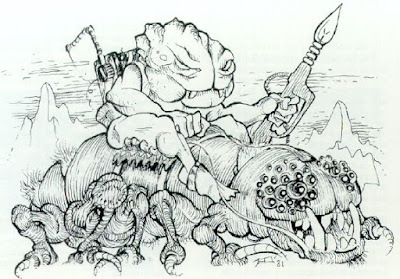 These are less than half the original illustrations appearing in the issue, but they're the ones that stood out as being especially worth of comment. Should there be interest, I may post more examples of this artwork in the weeks to come. For now, I thought it sufficed to draw your attention to these, all of which caught my eye as I was reading.
These are less than half the original illustrations appearing in the issue, but they're the ones that stood out as being especially worth of comment. Should there be interest, I may post more examples of this artwork in the weeks to come. For now, I thought it sufficed to draw your attention to these, all of which caught my eye as I was reading.
Polyhedron: Issue #3
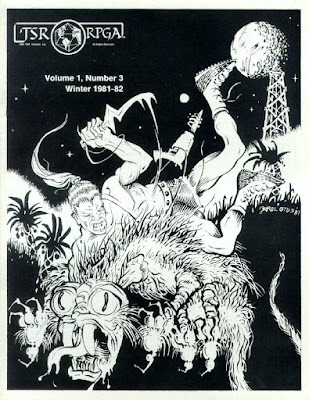 Issue #3 of the technically-still-unnamed Polyhedron newsletter (Winter 1981–82) is notable for numerous reasons, starting with the absolutely gorgeous piece of Erol Otus Gamma World art that graces its cover. It's yet another glimpse of an alternate reality where TSR better supported its post-apocalyptic science fantasy game. Of course, the issue is filled with remarkable – and original – illustrations by TSR's stable of artists, so many, in fact, that I'll probably make another post highlighting some of them.
Issue #3 of the technically-still-unnamed Polyhedron newsletter (Winter 1981–82) is notable for numerous reasons, starting with the absolutely gorgeous piece of Erol Otus Gamma World art that graces its cover. It's yet another glimpse of an alternate reality where TSR better supported its post-apocalyptic science fantasy game. Of course, the issue is filled with remarkable – and original – illustrations by TSR's stable of artists, so many, in fact, that I'll probably make another post highlighting some of them.
The issue is double the size of the previous two issues (32 pages), though editor Frank Mentzer mentions that it will return to 16 pages with issue #4. The reason for that is, starting with that issue, the newsletter will appear bimonthly rather than quarterly. Mentzer also announces the establishment of a $1000 RPGA Scholarship Fund to the college-bound RPGA member "with the highest College Entrance Examination Board scores or equivalent thereof." Though I didn't subscribe to Polyhedron until a few issues later, I do remember the announcement of the winner of the scholarship each year.
Issue #3 sees the inauguration of Mentzer's "Where I'm Coming From" column, which he calls "my podium." This first installment isn't all that insightful. It's mostly a paean to the RPGA Network and thanks to readers for the warm response to the newsletter. "Dispel Confusion" continues, though it's no longer credited to a single TSR but simply to "The Game Wizards." As ever, it's an interesting look into the minds of the more rules-obsessed gamers of the early '80s. There's a question about surprise, for example, that brought to light the fact that, in by-the-book AD&D, each segment a character is surprised, he is subject to a full round's worth of attacks – up to five. I can honestly say I have never played the game this way nor have I ever seen anyone else do so, but then it's been long established on this blog that I frequently do it wrong. Oh well!
There is a massive – 7-page – interview with James Ward that is well worth discussing in its own right. Naturally, Ward has a lot to say about Gamma World, among other topics, which is what most interests me, given my lifelong fondness for the game. Dawn Patrol gets two articles devoted to it, the first of which is a report about the results of a tournament at the most recent GenCon. The article includes a turn-by-turn recap of a dogfight between five German and three American planes that ended in a German victory. The second article is another Dawn Patrol by Mike Carr, this time focusing on medals and commendations. Like Gamma World, Dawn Patrol is another game for which I have great fondness, but, unlike GW, I have not played it in decades. One of these years, I may have to fix that.
Don Turnbull's "Turnbull Talking" returns. He devotes himself to the question of just what hit points actually represent, a perennial topic of debate in the old days (and perhaps even nowadays, come to think of it). Michael W. Brunton's "Figure Painting" is just that, a three-page article about the ins and outs of painting figures for use with roleplaying games. Sadly, unlike similar articles in the pages of White Dwarf, no photographs accompany it, which makes the piece a lot less appealing to a painting-impaired reader like myself. Then we get three more pages of "Convention Wrapup," in which the events of GenCon XIV and GenCon East are reported. The focus is naturally on the results of the RPGA AD&D tournaments, as one might expect.
Merle Rasmussen announces a "Top Secret™ Gadget Contest." I'll be curious to see the results of the contest when they're revealed in a later issue. More immediately interesting is the piece of Erol Otus artwork that accompanies the article.
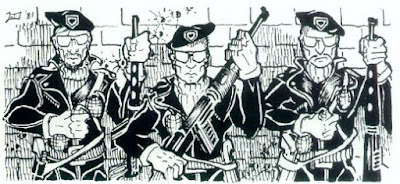 The uncredited "Codebook" is a brief meditation on the use of codes and cyphers in RPGs, followed by four coded messages that are presented as part of a contest for readers to decipher. Later, there's also a Gamma World art contest – there sure are a lot of contests in this issue – in which readers are called upon to illustrate the monsters presented in issue #2 and in this issue. "Mutants: A Continued Sampling of the Weak Ones" by James Ward gives us four more opponents for use with the game. I was (and am) a sucker for stuff like this, so I was happy to see more of it here.
The uncredited "Codebook" is a brief meditation on the use of codes and cyphers in RPGs, followed by four coded messages that are presented as part of a contest for readers to decipher. Later, there's also a Gamma World art contest – there sure are a lot of contests in this issue – in which readers are called upon to illustrate the monsters presented in issue #2 and in this issue. "Mutants: A Continued Sampling of the Weak Ones" by James Ward gives us four more opponents for use with the game. I was (and am) a sucker for stuff like this, so I was happy to see more of it here.There are more reader-created tricks and traps in "Notes for the Dungeon Master," alongside "Notes from Overseas" by Don Turnbull. Also present is an uncredited full-page article "Spelling Bee" that looks at the use and abuse of the invisibility spell. "Saga of Marnie" by Marnie Bosch is a firsthand account of someone's experiences at GenCon East in July 1981. "Incomplete Convention Schedule '82" is simply a listing of gaming cons for the coming year. I was interested to see that Origins 82 was held in my old hometown of Baltimore that year. I never actually attended Origins until 1991, even though it was often held in and around Baltimore. What can I say? Cons were not a big part of my formative experiences in the hobby (and still aren't, though I should make a stronger effort to change that).
As I said at the beginning, issue #3 of Polyhedron is a significant one, demonstrating that it's already growing and changing in response to its increased readership. Having no direct experience with the RPGA itself, I can't help but wonder how successful it was during the first part of the 1980s. Certainly TSR seems to have placed great stock in it, if Polyhedron is any indication.
July 30, 2023
Pulp Fantasy Library: The Haunter of the Dark
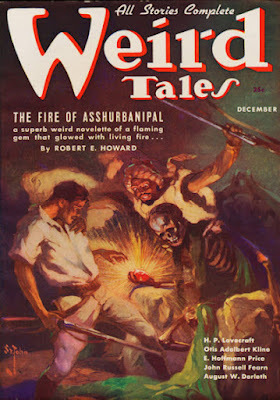 In the last post of this series, I looked at Robert Bloch's "The Shambler from the Stars," both because it's a decent story in its own right and because it was intended by its author as a darkly humorous homage to his friend and mentor, H.P. Lovecraft. HPL was apparently quite taken with the story, so much so, in fact, that he took up the gauntlet thrown by his youthful colleague, producing a sequel of sorts, in which he exacts his literary revenge. Entitled "The Haunter of the Dark," the story would first appear in the December 1936 issue of the Unique Magazine. It would also be his last story to appear in print before his death the following March.
In the last post of this series, I looked at Robert Bloch's "The Shambler from the Stars," both because it's a decent story in its own right and because it was intended by its author as a darkly humorous homage to his friend and mentor, H.P. Lovecraft. HPL was apparently quite taken with the story, so much so, in fact, that he took up the gauntlet thrown by his youthful colleague, producing a sequel of sorts, in which he exacts his literary revenge. Entitled "The Haunter of the Dark," the story would first appear in the December 1936 issue of the Unique Magazine. It would also be his last story to appear in print before his death the following March.The tale concerns a young writer of weird fiction, Robert Blake, whose name is a none too subtle evocation of Bloch's own. Blake is also intended to be the nameless narrator of "The Shambler from the Stars," a fact Lovecraft makes clear on multiple occasions in his own story. After the unfortunate events of the previous yarn, Blake has returned to Providence, Rhode Island and taken up residence in "the upper floor of a venerable dwelling in a grassy court off College Street." From his window, Blake can see – and becomes fascinated by – "a certain huge, dark church."
It stood out with especial distinctness at certain hours of the day, and at sunset the great tower and tapering steeple loomed blackly against the flaming sky. It seemed to rest on especially high ground; for the grimy facade, and the obliquely seen north side with sloping roof and the tops of great pointed windows, rose boldly above the tangle of surrounding ridgepoles and chimney-pots. Peculiarly grim and austere, it appeared to be built of stone, stained and weathered with the smoke and storms of a century and more.Blake's fascination is so strong that he spends much of the winter staring at the church, pondering "the far-off, forbidding structure."
Since the vast windows were never lighted, he knew that it must be vacant. The longer he watched, the more his imagination worked, till at length he began to fancy curious things. He believed that a vague, singular aura of desolation hovered over the place, so that even the pigeons and swallows shunned its smoky eaves. Around other towers and belfries his glass would reveal great flocks of birds, but here they never rested. At least, that is what he thought and set down in his diary. He pointed the place out to several friends, but none of them had even been on Federal Hill or possessed the faintest notion of what the church was or had been.
In late April, Blake finally decides to pay a visit to the church and sneak inside. He finds it to be "in a state of great decrepitude," with "a touch of the dimly sinister" suffusing the place. He also finds "a rotting desk and ceiling-high shelves of mildewed, disintegrating books" whose abhorrent titles he recognizes like the Necronomicon, Liber Ivonis, Cultes des Goules, Unaussprechlichen Kulten, and more – hardly the kinds of volumes Blake expects to find in a church!
Even more bizarre were the contents of a room located just below the church's steeple.
The room, about fifteen feet square, was faintly lighted by four lancet windows, one on each side, which were glazed within their screening of decayed louver-boards. These had been further fitted with tight, opaque screens, but the latter were now largely rotted away. In the centre of the dust-laden floor rose a curiously angled stone pillar some four feet in height and two in average diameter, covered on each side with bizarre, crudely incised, and wholly unrecognisable hieroglyphs. On this pillar rested a metal box of peculiarly asymmetrical form; its hinged lid thrown back, and its interior holding what looked beneath the decade-deep dust to be an egg-shaped or irregularly spherical object some four inches through.
Inside the metal box was a "four-inch seeming sphere" that
turned out to be a nearly black, red-striated polyhedron with many irregular flat surfaces; either a very remarkable crystal of some sort, or an artificial object of carved and highly polished mineral matter. It did not touch the bottom of the box, but was held suspended by means of a metal band around its centre, with seven queerly designed supports extending horizontally to angles of the box’s inner wall near the top. This stone, once exposed, exerted upon Blake an almost alarming fascination. He could scarcely tear his eyes from it, and as he looked at its glistening surfaces he almost fancied it was transparent, with half-formed worlds of wonder within. Into his mind floated pictures of alien orbs with great stone towers, and other orbs with titan mountains and no mark of life, and still remoter spaces where only a stirring in vague blacknesses told of the presence of consciousness and will.
When, at last, Blake succeeds in looking away from the contents of the box, he notices that nearby there lies a "singular mound of dust" that turns out to be a human skeleton, still wearing the shreds of a man's suit and bearing a reporter's badge for the Providence Telegram newspaper. Also present is "a crumbling leather pocketbook" containing some disjointed handwritten notes. The notes suggest that the Starry Wisdom church was engaged in "devil-worship" involving a "box found in Egyptian ruins." The notes further suggest that the box contained "the Shining Trapezohedron" that "shews them heaven & other worlds" and that, through it, "the Haunter of the Dark tells them secrets." This information is enough for Blake, who, after a phantasmagoric reverie, flees the church.
Naturally, this is only the beginning of Robert Blake's investigations. The remainder of the story depicts the consequences of his having discovered the Shining Trapezohedron. "The Haunter of the Dark," though its plot has implications for the wider world, is a much smaller tale than many of Lovecraft's other efforts. The focus remains largely on Blake and what happens to him because of his unbound curiosity about the Starry Wisdom church. Readers looking for anything larger in scope might be disappointed, but I feel its more limited parameters gives the story an almost intimate feel that is often lacking in HPL's earlier stories. Perhaps that's because Lovecraft wrote it as an homage to a correspondent and friend, elevating it, if only a little, above a mere tale of cosmic horror. In any event, "The Haunter of the Dark" is suspenseful and well worth reading.
July 29, 2023
Slow and Steady
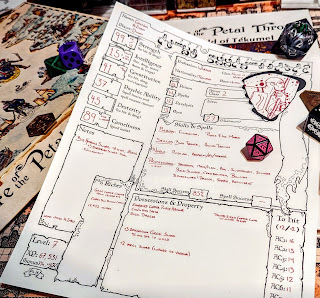 My House of Worms Empire of the Petal Throne campaign began in early March 2015 with six players. Eight years later, there are now seven players, four of whom have been there since the beginning. However, because of EPT's unusual approach to experience points and leveling, the rate at which these characters have advanced has been slow, even though most of them have taken part in more than 300 sessions. Indeed, until our most recent session, there was only a single character who'd reached the lofty heights of 7th level – and he only did so through the use of a magical tome (EPT's equivalent to the manual of puissant skill at arms).
My House of Worms Empire of the Petal Throne campaign began in early March 2015 with six players. Eight years later, there are now seven players, four of whom have been there since the beginning. However, because of EPT's unusual approach to experience points and leveling, the rate at which these characters have advanced has been slow, even though most of them have taken part in more than 300 sessions. Indeed, until our most recent session, there was only a single character who'd reached the lofty heights of 7th level – and he only did so through the use of a magical tome (EPT's equivalent to the manual of puissant skill at arms).That all changed this week. The characters all received a fairly large sum of experience points, thanks largely to their battles against high hit dice monsters (100 XP per HD according to the rules). This sum pushed two characters across the line into 7th level and brought several others closer to that mark. One of the newly minted 7th-level characters is Grujúng hiZnáyu, played by cartographer extraordinaire, Dyson Logos. Dyson celebrates this milestone briefly on his own blog, which is where the image above originally appeared (that's Grujúng's actual character sheet, in case anyone's interested).
About a year ago, I pondered the question of whether advancement rules are even necessary in RPGs, based on my experience of refereeing House of Worms all these years. I suppose it's inevitable I'd ponder it again after this past week's session. My feeling remains that, while it's not absolutely necessary that characters mechanically advance in a roleplaying game, it is important that they advance in some way. In the House of Worms campaign, for example, the characters have advanced socially over the course of time, gaining new ranks and positions within Tsolyáni society, as well as the prestige and influence that goes with such advances. That higher hit points or more spells were among the benefits they gained didn't matter for the most part. What did matter is that the players could see their successes had positive consequences for their characters, however they were quantified.
July 27, 2023
85 Years Ago
 On this date in 1938, Ernest Gary Gygax was born. No one reading this blog needs to be told who he was or why he holds such an importance place in the history of our shared hobby. Nevertheless, I thought it appropriate to briefly mark the anniversary of his birth by sharing of a photograph of Gygax that I've always liked. It's a wonderfully whimsical and lighthearted image that gives us a little glimpse of the man who, whatever his other virtues and flaws, truly loved games. In a 2004 interview with GameSpy, Gygax said as much about himself:
On this date in 1938, Ernest Gary Gygax was born. No one reading this blog needs to be told who he was or why he holds such an importance place in the history of our shared hobby. Nevertheless, I thought it appropriate to briefly mark the anniversary of his birth by sharing of a photograph of Gygax that I've always liked. It's a wonderfully whimsical and lighthearted image that gives us a little glimpse of the man who, whatever his other virtues and flaws, truly loved games. In a 2004 interview with GameSpy, Gygax said as much about himself:"I would like the world to remember me as the guy who really enjoyed playing games and sharing his knowledge and his fun pastimes with everybody else."
And that is how I shall remember him, especially today. Thanks for decades of fun, Mr Gygax. The world – not to mention my own life – is better for your having been in it.
Splitting the Party
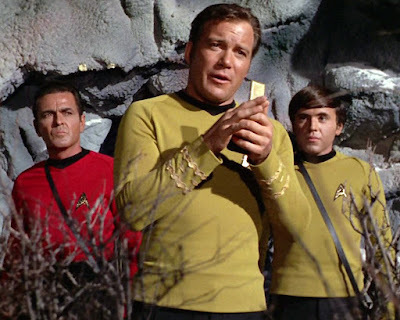 Within a few years of my entrance into the hobby, my friends and I were playing a wide range of different RPGs. Dungeons & Dragons remained our staple, of course, but we also regularly played other games. Playing those other games not only cleansed our palates genre-wise, but also medium-wise. For example, Champions and
Marvel Super Heroes
, being inspired by the medium of comic books, both included game mechanics intended to emulate the kinds of things you'd see in the sequential storytelling of those four-color magazines. Consequently, when we played those RPGs, we made an effort to do so in a way that mimicked the action we'd see in issues of our favorite DC or Marvel titles. I'm not sure we did this consciously. More likely, it was simply something that seemed right, given how clearly (and explicitly, in the case of Marvel Super Heroes) these games modeled themselves after their source material.
Within a few years of my entrance into the hobby, my friends and I were playing a wide range of different RPGs. Dungeons & Dragons remained our staple, of course, but we also regularly played other games. Playing those other games not only cleansed our palates genre-wise, but also medium-wise. For example, Champions and
Marvel Super Heroes
, being inspired by the medium of comic books, both included game mechanics intended to emulate the kinds of things you'd see in the sequential storytelling of those four-color magazines. Consequently, when we played those RPGs, we made an effort to do so in a way that mimicked the action we'd see in issues of our favorite DC or Marvel titles. I'm not sure we did this consciously. More likely, it was simply something that seemed right, given how clearly (and explicitly, in the case of Marvel Super Heroes) these games modeled themselves after their source material.This mindset carried over into other RPGs, too. One that sticks very firmly in my mind – and that's relevant to the larger topic I want to discuss in this post – is Star Trek the Role Playing Game. As I've no doubt said too many times before, Star Trek was my original fandom, the gateway through which I entered more solidly into the wider world of nerdery. When FASA published their RPG adaptation of the TV series in 1982, I snapped it up immediately and ran the game almost non-stop over the course of several years in the mid-80s. Though the rules of the game made some effort to model the conventions of the show – the starship combat system is perhaps the most successful instance of this – they weren't as strongly wedded to emulation of that kind as were the superhero roleplaying games I mentioned above.
Even so, my friends and I, as if by suggestion, tried to replicate the beats of the 1966 Star Trek series as best we could in play. One of the ways I attempted this – I say "I," because I was almost always the referee – could be seen in my handling of landing parties. In our sessions, as in the television program, characters would sometimes split up, with some of them remaining aboard ship, while others transported down to the planet it was orbiting. The two groups would stay in communication with one another, conveying useful information back in forth, but there were often times when they were out of contact for short or extended periods of time. Occasionally, the lack of communication between ship and landing party was a major plot point, with each group of characters having to deal with a problem in isolation, with only part of the overall picture available to them.
This set-up makes for good drama and I thought it'd make for good roleplaying too, especially since my friends and I were all fairly committed to bringing our sessions in line with the TV show. In those days, we regularly played in the basement of the home of two brothers. In sessions where one group of characters beamed down to a planet and another stayed in orbit, I'd physically separate them, sending one group upstairs to the living room or kitchen, while leaving the other in the basement. I'd shuttle back and forth between each group, handling their current situation in isolation. When they communicated with each other, I'd allow a player from one group to go to the other and they'd exchange information, as if they were using a communicator. This approach, while it slowed down play and involved a lot of running back and forth on my part, was often quite effective. I can still recall several sessions where the ignorance of one group of characters about the activities of the other led to memorable moments of roleplaying (and humor). Nowadays, I could probably handle this much more easily and effectively with technology unavailable to us in the 1980s.
Ironically, in my House of Worms campaign, the characters recently found themselves in a situation where I could have made use of a technological solution – and I didn't do so. While exploring a mysterious location, the characters came across a large, pillar-like object with multiple open apertures leading inside. After some experimentation to determine that it was probably safe, several of them entered and all found themselves in a different place. As some of them eventually discovered, the pillar was a device of the Ancients called a superposition enclosure and it was being used to hold an Undying Wizard called Getúkmetèk prisoner. Each of the characters who entered found himself in a separate reality in which he experienced a possible past/present/future where he had achieved some goal he greatly desired. Meanwhile, there were several characters outside the superposition enclosure, none of whom had any idea what was going inside it.
Bear in mind that House of Worms has been, since its inception in 2015, an entirely online game. We use Discord for voice chat and the campaign's server could easily accommodate separate voice channels into which I could separate all the characters so that their players would have no idea what was happening elsewhere. I didn't do this, however, and I'm not entirely sure why. Part of it, I suspect, is that I was simply lazy. Unlike my teenage self, the thought of popping back and forth between voice channels seemed like too much work, even though the end result might have been dramatically effective. Part of it, too, is that I worry about players losing focus while I tended to a player segregated in his own channel. As I have been running it, all the players have the chance to hear what's happening to their comrades, even if their characters do not. That keeps everyone engaged and, more than once, hearing the reactions of the players to things their characters do not know was positively delightful.
Does anyone reading this have any experiences with this sort of thing? Have you ever split up players in this fashion and, if so, how did it turn out? I'm quite curious to know how others have done it.
July 25, 2023
Polyhedron: Issue #2
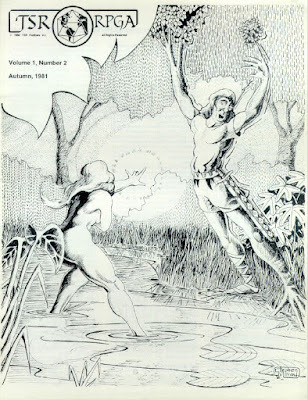 Issue #2 of the soon-to-be named RPGA Newsletter (Autumn 1981) features a cover illustration by Stephen D. Sullivan, depicting an unfortunate encounter with a bathing nymph. Sullivan tends to be forgotten as a TSR artist, probably because his contemporaries, like Erol Otus, Jeff Dee, and Bill Willingham, all loom larger in our collective memories of the late '70s and early 1980s. Consequently, I always enjoy seeing his artwork and being reminded that, yes, TSR did in fact employ other illustrators at that time.
Issue #2 of the soon-to-be named RPGA Newsletter (Autumn 1981) features a cover illustration by Stephen D. Sullivan, depicting an unfortunate encounter with a bathing nymph. Sullivan tends to be forgotten as a TSR artist, probably because his contemporaries, like Erol Otus, Jeff Dee, and Bill Willingham, all loom larger in our collective memories of the late '70s and early 1980s. Consequently, I always enjoy seeing his artwork and being reminded that, yes, TSR did in fact employ other illustrators at that time."Dispel Confusion" continues, though this time all the questions pertain to AD&D and are answered by Gary Gygax. Whenever I read columns like this, I'm always struck by just how different my own early experiences of roleplaying games must have been compared to those of others. Undoubtedly my friends and I were doing it wrong, but we rarely focused on the minutiae of rules interpretation and, on those occasions when we did, we never even considered the possibility of asking TSR for an "official" clarification. I've always played RPGs in a rather fast and loose fashion, trusting in common sense and on-the-fly judgment to fill in any gaps. Call me weird.
Speaking of Gygax, the second part of the interview begun in the previous issue appears here. As with the previous installment, this one is quite interesting, particularly for those of us interested in the history of the hobby. For example, Gygax talks a little bit about his work on AD&D module T2, which, of course, he never finished himself, handing it over instead to Frank Mentzer. He also mentions "the plane modules I want to do. I want to do the elemental planes, para-elemental planes, demi-planes and semi-planes, and demi-semi-planes, et cetera ..." Of all the D&D products that never were, my own thoughts drift most often toward Gygax's planar modules and supplements. I would have loved to see what he'd have done with the concept, since, from other statements he made over the years, it's clear he saw the planes as the playground of high-level characters in AD&D and that sounds terrific.
Mike Carr's "Dawn Patrol™ Preview" focuses on the creation of pilots for use with the upcoming game of World War I aerial combat. It's basically a two-page excerpt from the soon-to-be-published game, hoping to generate interest in it. Much more interesting is "How to Create Monsters for D&D® Basic and Expert Games" by Jean Wells. Wells explains that, because D&D, unlike AD&D, has comparatively few monsters, referees are likely to want to create new ones, but there's a lot to consider when doing so. She then devotes a nearly two-page article discussing various aspects of D&D monster design as she creates a new monster step-by-step. I like articles that balance the theoretical with the practical and this one does that nicely. It's also a reminder that Jean Wells was a much better designer and writer than she's often given credit for.
"Turnbull Talking" is a reprint of a short article by Don Turnbull, head of TSR UK at the time, in which he talks – rambles is perhaps more accurate – about the growth and development of the larger hobby. It's really a space filler rather than a substantial article. On the other hand, "Mutants: A Representative Sample of the Weak Ones" by James M. Ward is quite meaty. Ward presents a variety of new opponents for use with Gamma World. Despite the title, not all of these opponents are mutants, nor are they in any sense "weak." All, however, are imaginative and make me wish that, during his time at TSR, Ward had produced more support material for Gamma World. It is a mystery to me why he did not.
Also included in the issue is a RPGA Gift Catalog, featuring many of the items listed here. To this day, I wish I'd bought the "fighters wheel" gadget. "Notes for the Dungeon Master" includes more tricks and traps for use by the referee in his dungeons, as submitted by Polyhedron readers. It's amazing to me how many of these tricks are intended to foil or frustrate mapping – a reminder, I think, of just how important good cartography was in the early days of D&D. "Top Secret Transmissions" by Allen Hammack talks a bit about the popularity of "commando raid" missions for Top Secret, in part because of how much players enjoy loading their characters up with lots of weaponry. What Hammack says is true in my own experience and may go some way toward explaining why espionage RPGs have never been as popular as the books and movies that inspired them.
This issue's installment of "Rocksnoz" by Tom Wham is not a comic but rather a bit of background about the setting of the comic itself. Wham explains that, "in this very universe, before the last big bang, there was a world very similar to ours." This world, called Nidd, was inhabited by intelligent beings called "huemans." Despite its similarity to Earth, on Nidd "no chemicals combine to make gunpowder, and nuclear weapons are impossible. To make up for this deficiency, the denizens of Nidd have turned to magic." It's an odd little article but a strangely fascinating one, if only to see into the mind of Wham and his conception of fantasy. Finally, there's "The RPGA Scoring System," which lays out recent changes to the way that the RPGA evaluates players and DMs in its tournaments. Since I'm unfamiliar with the original system, I can't say this article held much interest for me, but it's probably of interest to those looking into the history of organized play.
Issue #2 of Polyhedron predates the years when I subscribed to it, so much of what's in it is new to me. What's most notable about it is its roughness. Were it not published by TSR and filled with articles by its staff, it'd be hard to tell it apart from a high-end fanzine of the same era. I think that's what's most appealing about it and why I look forward to exploring it over the coming months.
July 22, 2023
REVIEW: Black Sword Hack
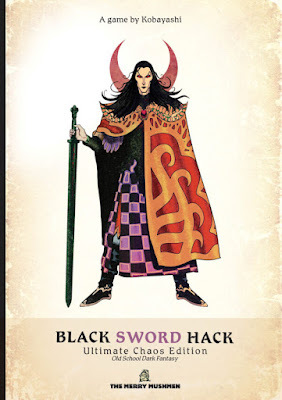 During the nearly eight years this blog was inactive, I wasn't paying nearly as much attention to the wider old school roleplaying scene as I previously had been. Consequently, quite a number of releases, trends, and fads within this sphere completely passed me by. One of these was The Black Hack, a streamlined class-and-level RPG by David Black, whose first edition appeared in 2016. For a time, I am given to understand, The Black Hack and its design principles were much favored, leading to a proliferation of "Hacks" – Bluehack (for Holmes D&D), The Rad-Hack (Gamma World, etc.), Cthulhu Hack (Call of Cthulhu), even The Petal Hack (Empire of the Petal Throne), among many, many more.
During the nearly eight years this blog was inactive, I wasn't paying nearly as much attention to the wider old school roleplaying scene as I previously had been. Consequently, quite a number of releases, trends, and fads within this sphere completely passed me by. One of these was The Black Hack, a streamlined class-and-level RPG by David Black, whose first edition appeared in 2016. For a time, I am given to understand, The Black Hack and its design principles were much favored, leading to a proliferation of "Hacks" – Bluehack (for Holmes D&D), The Rad-Hack (Gamma World, etc.), Cthulhu Hack (Call of Cthulhu), even The Petal Hack (Empire of the Petal Throne), among many, many more.
Now, there's nothing inherently wrong with any of this. Gamers are as prone to enthusiasms as the next person and I try not to begrudge anyone else their preferences, even if I don't share them. Still, I can't deny that the intensity of the ardor for The Black Hack put me off looking into it for some time. What can I say: I'm prone to contrariness. When I finally did read The Black Hack for myself, I found it more agreeable than I expected, despite my dislike of certain aspects of its design. That's not knock against it, of course; I generally dislike certain aspects of most games' designs. That's more or less the nature of the beast.
That's why Black Sword Hack took me by surprise. I didn't even know it existed until it showed up in my mailbox one day as a complimentary copy sent to me by its publisher, The Merry Mushmen (best known for Knock!). Written by Alexandre "Kobayashi" Jeanette, Black Sword Hack is, in his words, "a dark fantasy roleplaying game inspired (but not limited to) the works of R.E. Howard, Michael Moorcock, Karl Edward Wagner's Kane series, Fritz Leiber's Lankhmar and Jack Vance's Dying Earth books." Being a fan of all those writers and their pulp fantasies, that description certainly got my attention, as did the eye-catching artwork by Goran Gligović, which can be found throughout the full-color, 112-page, A5-sized, hardcover book.
The core rules of Black Sword Hack are simple. A turn is an abstract measure of time, during which time a player character may act. During a time, a character can typically take two actions, such as movement and combat. All actions are resolved by making an attribute test. The goal of a test is to roll under a character's appropriate attribute score with a d20. A roll of 1 is always a critical success, while a roll of 20 is always a critical failure. I must admit that the lower-is-better d20 roll takes some getting used to, since it runs counter to decades of experience as a player of roleplaying games, but otherwise the rules of Black Sword Hack are straightforward.
The game retains the "Usage die" from The Black Hack, but with a twist. For those unfamiliar with it, the Usage die is a way to keep track of resources that have limited quantities, like rations or arrows. Whenever a resource is used, the die is rolled and, if the result is 1 or 2, the die "degrades" to the next die type (e.g. d8 becomes d6) until d4 is reached and 1 or 2 is rolled, at which point the resource is completely depleted. Black Sword Hack does not employ the Usage die for concrete resources, but only for abstract ones, like influence, debts, etc. Further, there is the Doom die, a type of Usage die that represents "the attention of Law and Chaos" on the characters. It's rolled whenever the character critically fails and under certain other specific conditions. Once the Doom die is depleted, the character makes all his tests and damage rolls with Disadvantage (i.e. rolling two dice and taking the lowest result).
While the D&D pedigree of Black Sword Hack (and The Black Hack on which it is based) is readily apparent (STR, DEX, CON, etc.), the game is class-less, placing greater emphasis on a character's origin (barbarian, civilized, or decadent) and background (berserker, diplomat, assassin, etc.). This provides a looser mechanical framework for characters, in keeping with the wide range of possible dark fantasy settings the referee might create (more on this in a bit). Characters can also acquire "gifts" – powers of Balance, Chaos, or Law – in addition to sorcery, faerie ties, twisted science, and runic weapons. As characters gain experience, they accrue more abilities and hit points, but a high-level Black Sword Hack character is much less robust than a D&D character of similar level. Consequently, combat is much more fraught with danger, which makes sense, given its literary inspirations.
Where Black Sword Hack really shines, though, is its world building tools. Approximately half the book is devoted to the referee – more if you include its sample bestiary. The game assumes the referee will create his own setting, one dominated by the struggle between Law and Chaos, as in Moorcock and Anderson's fantasies. There are tables and examples to aid him in deciding on the nature of the struggle and how it manifests in the setting, along numerous adventure seeds, two adventure, and the sketch of an entire city. There's even a sketch of a setting, complete with a map, to show one way to make use of the world building tools.
A conceit of the referee section is that any setting the referee designs will inevitably include certain stock locales – Forbidden City, Amber Enclave, Merchant League, Northern Raiders, etc. These are not just tropes from dark fantasy fiction but perhaps also eternal archetypes that reappear throughout the multiverse. Creating a setting for Black Sword Hack involves drawing a map and placing all these locales onto it somewhere and then fleshing out the details through play and the judicious use of random tables provided in the book. It's a clever approach and one that genuinely helps guide the referee in a useful way. The same goes, I think, with the bestiary, which includes plenty of archetypal enemies – demons, cannibals, serpent people – to spark the imagination, while still providing the tools needed to create unique and original antagonists.
If Black Sword Hack has a flaw, it's its looseness. Some players and referees may find its relative lack of concern for considering every possibility, whether in the rules or its myriad settings, disappointing. If you prefer something more defined, even concrete, you're better off with other options. Black Sword Hack revels in its light, almost freeform, rules and malleable setting elements and that won't be to everyone's taste. But as someone who's come to realize that my own preferences tend toward simple, flexible rules with lots of room for filling in the details as I go, this is right up my alley. When I get around to running that Stormbringer campaign of my dreams, there's no question in my mind that I'll be using Black Sword Hack. Perhaps others will like it too.
Black Sword Hack is available directly from the Merry Mushmen website in either print or PDF form.
July 19, 2023
Elemental Honorifics II
A year and a half ago, I wrote a post about the honorifics associated with the five primordial elements of the sha-Arthan. In the time since, I've been further developing these aspects of the setting, including their visual representation. Thanks to the talents of Zhu Bajiee, who's already provided me with so much evocative artwork, I now have glyphs for each of the elements, as shown below.
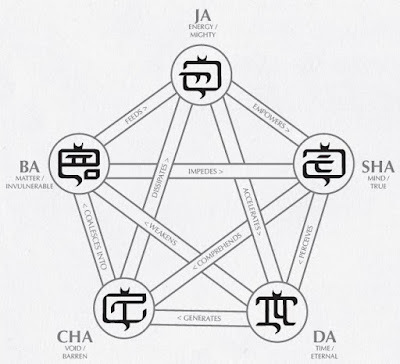 The glyphs derive from the Exalted Speech of the Makers that is also employed in sorcery and alchemy. Whenever an honorific is used in certain languages (e.g. Onha), the glyph is appended to the start of the word, like so:
The glyphs derive from the Exalted Speech of the Makers that is also employed in sorcery and alchemy. Whenever an honorific is used in certain languages (e.g. Onha), the glyph is appended to the start of the word, like so:
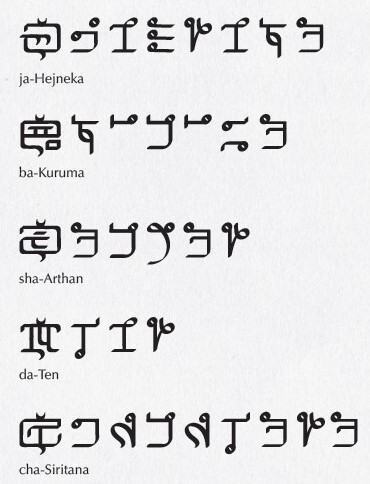 From a gameplay perspective, none of this matters in the slightest. It's purely a linguistic/graphical indulgence on my part, but I like it, because it's helped me to nail down the look and feel of sha-Arthan. That's not nothing, especially in a science fantasy setting that strays from the conventions of vanilla fantasy.
From a gameplay perspective, none of this matters in the slightest. It's purely a linguistic/graphical indulgence on my part, but I like it, because it's helped me to nail down the look and feel of sha-Arthan. That's not nothing, especially in a science fantasy setting that strays from the conventions of vanilla fantasy.
July 18, 2023
Into the Megadungeon
Additional episodes will be released on biweekly basis. Ben intends to produce 10 episodes as part of the first season of the podcast, with each episode featuring a different referee who's created and refereed a megadungeon campaign for an extended period of time. I have no idea how long he can keep the podcast going – I doubt Ben does either – but I think it's a worthy topic and I look forward to listening to the episodes as they're released.
James Maliszewski's Blog
- James Maliszewski's profile
- 3 followers



